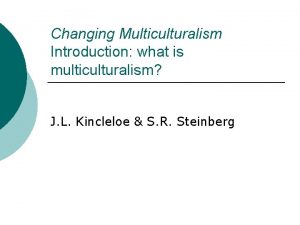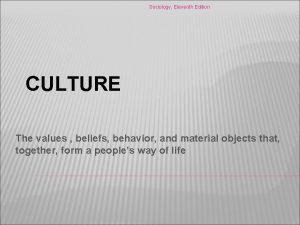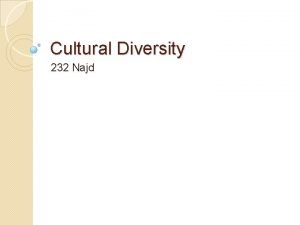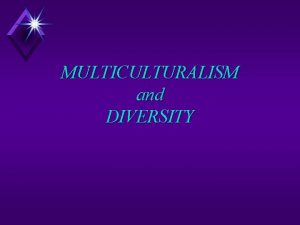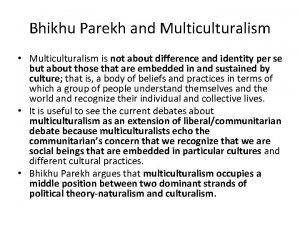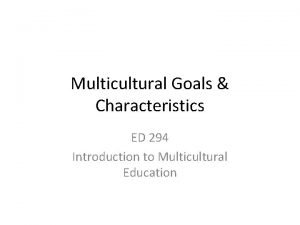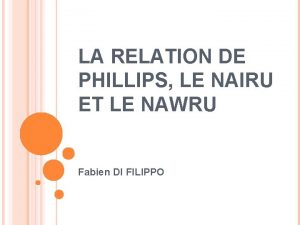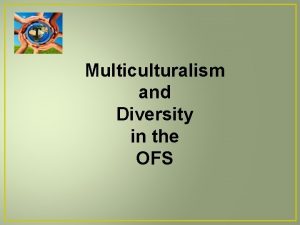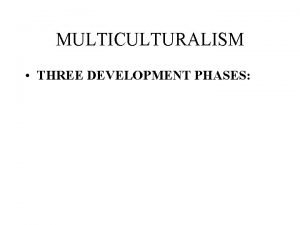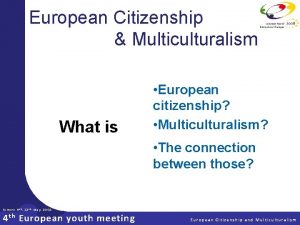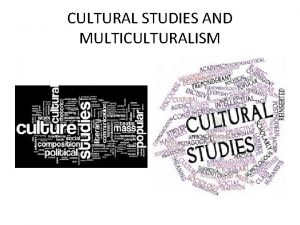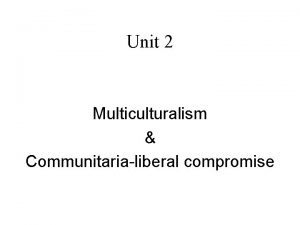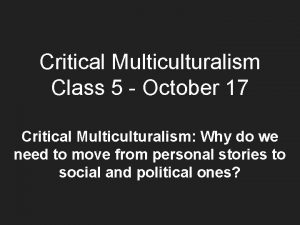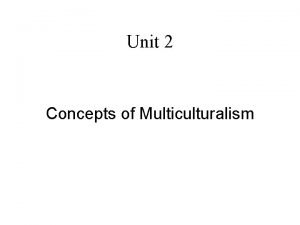What is Multiculturalism According to Anne Phillips Multiculturalism


















- Slides: 18

What is Multiculturalism?

• According to Anne Phillips, “Multiculturalism considers itself the route to a more tolerant and inclusive society because it recognizes that there is a diversity of cultures, and rejects the assimilation of these into the cultural traditions of the dominant group. ” (Phillips A: 2007).

• Theorists like Phillips assert that multiculturalism forces public policies to be remapped in such a way that every group gets equal access to information regardless of difference. Besides challenging the assumptions of monoculturalism, the components of multiculturalism force public policy to recognise the legitimacy of at least some cultural claims to prevent the blanket imposition of linear laws. One example is of turbaned Sikhs exempted from wearing safety helmets, as required by the law for motorcyclists by the Royal Canadian Mounted Police, by Canada’s Supreme Court. (Phillips, A: 2002).

• Vertovec interprets multiculturalism as, “A picture of society as a ‘mosaic’ of several bounded, nameable, individually homogeneous and unmeltable minority unicultures which are pinned onto the backdrop of a similarly chatacterised majority uniculture. ” (Vertovec, S in Modood, T: 1998)

Multiculturalism And Culture: • Culture, as explained by many theorists, is not frozen in time. It is “constantly negotiated and is multiple and contradictory. ” (Volpp, L: 2001) It is mandatory to recognise that culture is ‘hybrid’ and ‘contested’ and is not an antithesis to feminism. “Recognising that feminism exists within communities of colour breaks down the equation between multiculturalism and anti-feminism. ” (Volpp, L: 2001)). For Volpp, unlike Okin, there is no tension between multiculturalism and feminism and unlike Okin Volpp takes the position of recognizing the factor of ‘difference’ situated in multiculturalism without the danger of recalling cultural essentialism by positioning ‘their’ culture in opposition to ‘our’ culture.

• The problem arises when culture is essentialised and ascribed to a minority community where women are situated as subjects and seen as victims. One such case is that of Dong-lu Chen, a Chinese immigrant to New York which points out to how culture was invoked to validate an act of crime committed against a woman. Dong-lu Chen was accused of beating his wife to death whom he believed was in an adulterous relationship. At his trial in 1988 he took the cultural plea and told the jury that it was a Chinese custom to avenge a man’s dishonour by killing his adulterous wife. (Phillips, A: 2003).

Multiculturalism, Essentialism and Women’s Rights • When a woman from minority group is battered, oppressed or, at worst, killed why is the blame placed on culture? But when a woman from the majority group undergoes the same treatment the term culture is never used? Why should multiculturalism suffer at the hands of cultural essentialism?

• Cultural essentialism presumes the primordial existence of certain immutable characteristics, traits and qualities in individuals determining their behaviour. Such a deterministic approach when applied to culture constitutes cultural essentialism. If cultural essentialism is to be taken as a point of ascertaining individual behaviour, should it not be applied to crimes committed in the West against women? Leti Volpp raises issue with the select application of culture “when the defendants come form a racialised minority group. ” (Volpp, L: 2000)

• The danger of cultural essentialism is not restricted to its application on those women believed to be oppressed in a minority community by the dominant, patriarchal elements. The deployment of cultural essentialism by the majority to characterise transgressions against women of a minority community often leads to the suppression of rights of those same women whom the majority dominant community is purportedly striving to rescue from their ‘backward’ and ‘pre-modern’ culture.

• For example, the banning of the veil for women in public spaces by the Dutch parliamentarians in 2005 (Phillips, A: 2007) and a similar national ban imposed by France a year earlier indicate that multiculturalism is only half met when governments take it upon themselves to decide which cultural minority traditions will be accepted as liberal and which ones will be rejected as oppressive.

• It is presumed by some feminists and many political philosophers that when a Muslim woman drapes a veil around her head or covers her body with a long piece of cloth known as jilbab, she is doing so out of coercion with no element of agency involved in the decision.

• Veiling is perceived to conflict with secular, egalitarian principles as does polygamy, and when women reaffirm the employment of agency, especially in the case of veiling, “their voices are often discounted as simply reflecting community pressure. It is presumed that no woman would really choose to abase herself in this way. ” (Phillips, A: 2007).

• Are we to believe that ‘agency’ is only employed by the female embodied form to reveal and reconstruct physical contours, but when the same action is taken by the female embodied form to underplay sexuality by covering herself with a jilbab, it is believed to be without agency?

• According to the latest statistics released by the American Society for Aesthetic Plastic Surgery, approximately 10. 2 million cosmetic surgical procedures were performed in the United States in 2008. It is believed that since 1997 the number of cosmetic procedures has increased by 162 percent, with 92 per cent of these procedures being done by women. (ASFAP: 2009). • Are those women in the United States exercising agency without feeling coerced by the pressure to look beautiful as ‘beauty’ is defined in the American culture?

• D Meyers compares the reaction of an African mother consenting to her daughter’s infibulation with a Euro-American mother showing consideration for her daughter’s need to undergo reconstructive surgery on her genitals for biological determinism. Many would empathise with the American mother’s decision believing it to be the outcome of a free autonomous individual, but the same understanding is withheld in the case of the African mother. (Meyers, D T: 2000).

• The fixation about criticising cultures different from the majority runs a high risk of cultural essentialism, which endangers attempts to make society multicultural.

• What is elicited from these critiques is how multiculturalism has laid bare the cultural divides between the majority and minority groups, which feminists have mostly ignored by privileging gender over, race, culture, class and religion.

• Uma Narayan argues that the Third World women’s issues are seen as ‘different’, ‘alien’, and ‘other’, when compared to the problems besetting Western women. “Clitoridectomy and infibulation have become virtually an ‘icon’ of ‘African women’s problems’ in Western contexts, while a host of other ‘more familiar’ problems that different groups of African women face are held up at the border. ” (Narayan, U: 1997).
 Critical multiculturalism definition
Critical multiculturalism definition Multiculturalism negative effects
Multiculturalism negative effects Changing multiculturalism
Changing multiculturalism Multiculturalism sociology
Multiculturalism sociology Multiculturalism definition
Multiculturalism definition Multiculturalism examples
Multiculturalism examples Monument to multiculturalism
Monument to multiculturalism Definition of multiculturalism
Definition of multiculturalism Multiculturalism
Multiculturalism Bhikhu parekh multiculturalism upsc
Bhikhu parekh multiculturalism upsc Multiculturalism ap human geography
Multiculturalism ap human geography Examples of multiculturalism
Examples of multiculturalism Placemaking definition ap human geography
Placemaking definition ap human geography Jasmine richardsom
Jasmine richardsom Phillips curves
Phillips curves Kitty phillips
Kitty phillips Equação curva de phillips
Equação curva de phillips Courbe de phillips nairu
Courbe de phillips nairu Recessionary gap phillips curve
Recessionary gap phillips curve


